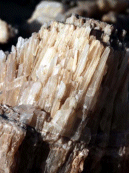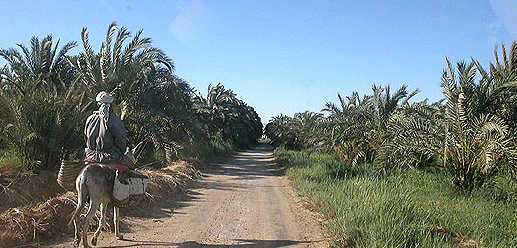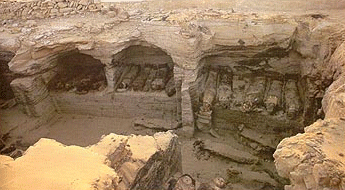Tours of Egypt, Egypt Tours - Shades of Egypt
Click here
to return to the Shades of Egypt Website
|

Tailor made 3 Day Tour - WESTERN DESERT “White
Desert”
(Ref : TM3DESERT)
|
DAY |
SUGGESTED ITIN |
ACCOMMODATION |
|
|
1 |
Transfer to Bahariya; check in hotel
Local safari tour: through the old centre of the oasis, the black
mountains, the sand dunes, salt lake, the gardens, pyramid
mountain.
At sunset we go to the mountains to see the ruin called "The
English House"
In the evening there is a possibility to visit the village and
the shops |
Hotel - Bahariya |
 |
|
2 |
After breakfast we start the safari tour to the White Desert
(about 180 km.).
This tour goes off and on road, with 4x4 cars. We will stop at
all the special areas between Bahariya and the White Desert, like:
- The black desert
- The valley of El Haize with the nice, warm spring; here
we can have lunch.
- The crystal mountains
- The valley of l'Agabat
- The White Desert
Safari camp in the White desert and enjoy a fresh meal
cooked for dinner - In the evening you can listen to traditional
Bedouin music |
Safari Camp |
 |
|
3 |
After breakfast we drive back to Bahariya
oasis and visit cultural places, like a museum (with a collection of
golden mummies), the 3 tombs and the ruin of Alexander the Great.
After lunch transfer to Cairo |
|
 |
Pricing and Details
(Prices quoted based on 2 persons sharing a double
room. Prices in UK sterling)
|
TOTAL TOUR PRICE...... |
|
1 & 2 Star |
3 & 4 Star |
5 Star |
|
N/A
 |
£ 212 per person
 |
N/A
 |
|
Click
here for Currency Conversion |
|
Tour Includes :-
- All accommodation.
- All Transfers
- Transportation (to and from all sites and destinations).
- English Speaking Guide.
- Most hotel stays include breakfast.
Items not included :-
- International Flights (See the flights section of this site
or contact us for advice on obtaining flights).
- Entrance fees to sites (most sites are around £2-3. A
full list is available on the "What to See" section of
this site).
- Egyptian Visa (Download a visa application in the visa
section of this site or contact us for information on obtaining
your visa).
Tour Notes
- Dates : All of our tours are
run to fit clients exact date / time requirements. Just let us
know what you require and the tour will be scheduled to fit it
with you.
- Single Supplement: For clients
travelling alone, tours will be subject to a single supplement -
please contact us for further details
|
|
|
|
holidays in egypt, egypt holidays, holidays in egypt, egypt holidays,
holidays in
egypt egypt
holidays western desert tours excursion
Western Desert
With a population of about 23,000, Siwa, the most inaccessible of all
Egypt's oasis until very recently, is also one of the most fascinating,
lying some 60 feed below sea level.. On the edge of the Great Sand Sea,
its rich history includes a visit from Alexander the Great to consult the
Oracle of Amun in 331 BC. Archaeologists, such as Liana Souvaltsis and
implied that the great military leader was burried here, but no real
evidence has come from this. The King of Persia lead a 50,000 man army to
the area to distroy the oracle, but the entire army was lost in the
desert.
The area has a nice climate, chilly in winter, hot in the summer and
moderate in the spring and autumn. Lake Siwa to the west of the town of is
a large, saltwater lake.

The area is famous for its dates and olives, and is one of the most
beautiful landscapes in Egpt. Olives oil is still made in the area by
crushing the olives from the 70,000 olive trees in the area with stones.
The dates are gathered by zaggala (stick bearers), who must remain
celibate until the age of forty, and the area boasts some 300,000 date
trees. It is located on the old date caravan route, yet until recently, it
received few other visitors and retained much of its heritage. In fact,
until the battles which took place around the oasis in World War II, it
was hardly governed by Egypt, and remained mostly a Berber (Zenatiya)
community for the prior thirteen centuries. Siwans continue to have their
own culture and customs and they speak a Berber language, called Siwi,
rather than Arabic. Interestingly, each October there is a three-day
festival during which Siwans must settle all of their past year's
disputes.
The area is also famous for its springs, of which there are
approximately 1,000. The water is sweet, and is said to have medical
properties.
Though relaxing and certainly now a part of the tourist community in
Egypt, it is very traditional, and visitors should keep this in mind when
traveling to the area. Girls of the area are often married by the age of
14, and afterward where completely covering clothing, and allowed little
communications with the world outside their immediate family. Many women
still wear traditional costumes and silver jewelry like those displayed in
The Traditional Siwan House museum in the town center. In fact, the area
is also well known for its crafts, particularly woven cloth, which is
unique in Egypt.
The Bahariya Oasis
Why pay 20 million dollars for a trip into space when you can go to the
moon for so much less? OK, its not really the moon, but the landscape is
surreal; alien in every way, and it changes from one moment to the next.
It is the type of place that creates wonder in adults, where such feelings
were long ago thought lost. It is a land not yet fully explored, with
twists and turns that reveal ever changing landscapes. This is the
Bahariya Oasis, and the nearby, or rather, encroaching western desert.
Over time, the Bahariya Oasis has had a number of different names. It
has been called the Northern Oasis, the Little Oasis, Zeszes, Oassis Parva
and the especially during the Christian era, the Oasis of al-Bahnasa,
along with various other names.
At one time, the Bahariya Oasis, as well as most of the rest of what is
today referred to as the Western (or Libyan) Desert, was the floor of an
immense ocean. Yet from about 3000 BC until the present, almost no
rainfall graces this part of the world, so groundwater is its life blood.
Remains of stone tools found in the Bahariya oasis evidence the
existence of settlements in the area as early as the Paleolithic Period.
In fact, we are told that anyone with a trained eye,walking about the
oasis, can spot prehistoric stone knives and and axes simply lying upon
the surface of the sand.

However, little real excavation has been carried out in the Oasis, at
least until the last several years, and so we know little of the history
of the Bahariya Oasis prior to Egypt's Middle Kingdom. What we do know
comes mostly from the work of Ahmed Fakhry, and 20th century Egyptologist,
who worked in the Oasis. Otherwise, most of the archaeological
investigation has been carried out by the local antiquity authorities, and
some recently by Zahi Hawass.
It is possible that during the Old Kingdom there may have been a
governor appointed to the Bahariya Oasis, as there was in Dakhla, but so
far we have no hard evidence that might support such an argument. In fact,
we hear of a people known as the Tjehenu, who inhabited the Western Desert
and were fair skinned with blond hair and blue eyes, and with whom the
early Egyptian's fought. However, its seems that the Bahariya Oasis was
originally inhabited by a mix of people from the Nile Valley and Bedouins
from Libya. At that time, evidence suggests that the Oasis was much larger
than it is now, but no settlements dating to the Predynastic, Early
Dynastic or Old Kingdom have thus far been unearthed.
By the Middle Kingdom, Bahariya was known as Zeszes, and definitely fell
under the control of the Egyptian kings, though only a single scarab
(inscribed with the name of Senusret) from that period has been found in
Bahariya. Yet, documentary evidence provides that both Amenemhet and
Senusret II began to pay considerable attention to the Oasis, probably to
deflect regular attacks from the Libyans. At that time, there must have
been large agricultural estates, large houses for the landowners, and even
military garrisons to keep marauders at bay. Agriculture was, as it is
now, of major importance to this community, and wine, as well as other
goods of the Oasis, made their way from here to the Nile Valley by donkey
caravans along two different routes.
However, during the 15th Dynasty, when Egypt was under the rule of the
Hyksos kings from Palestine, there was a lapse in trade with the Oasis,
presumably because the trade routes were unsafe. At that time, we find
only one text that refers to the Oasis, when King Kamose refers to it as
DjesDjes, the word for the region's famous wine.
According to Fakhry, under Tuthmosis III, many improvements were made in
the Oasis, including new water wells. His reign marked an increase in the
local population. At this time, the Oasis was under the control of Thinis
(Abydos), to which they paid tribute. We find visual evidence of this in
the private tomb of Rekhmire, who was Tuthmosis III's vizier. One scene
portrays the people of the Oasis, wearing striped kilts, presenting gifts
of mats, hides and wine. However, the Oasis apparently had at least a
governor who was a native of Bahariya, for the oldest tomb so far
discovered in the Oasis is that of Amenhotep Huy, where his title is given
as "Governor of the Northern Oasis". The tomb is dated to the
end of the 18th Dynasty or the beginning of the 19th. By the 19th Dynasty
of Egypt's New Kingdom, the Bahariya Oasis became even more important
because of its mineral abundance. Even today, the mining of iron ore
continues to be a vital industry. Even Ramesses II, in the Temple of Amun
at Luxor, refers to the Bahariya as a place of mining. Of course
agricultural products continued to be important in the Oasis, including
dates, grapes, figs, livestock and pigeons (for food).
By the time of Merenptah, Ramesses II's son, Egypt was suffering from
Libyan attacks, and the Bahariya, as well as the other Western Oasis, must
have suffered considerably during this time. Ramesses III defeated the
Libyans, and bought back some order to the desert region. However, it was
not until the Third Intermediate Period and particularly the Late Period
that Bahariya emerged as a major Egyptian center.
Shoshenq I, who founded the 22nd Dynasty under Libyan rule, along with
Shoshenq IV, seemed particularly interested in the Oasis. In fact, Fakhry
believed that the Libyans first captured the Farafra and Bahariya Oasis to
use as a base for their conquest of Egypt. They developed the region, and
ordered that government officials live in the community. We hear of an
official during this period named Weshet-het, holding the title "Superior
Libyan Chief", who was probably a governor, as well as another named
Arcawa who became governor and priest at the end of the 22nd Dynasty. Many
of its known antiquities date from this period.
Yet it was not until the 25th and 26th Dynasties that the Bahariya Oasis
florished as an important agricultural and trade center. Specifically, by
the 26th Dynasty, Bahariya prospered with its own governors who were
natives of the oasis. They apparently continued to report to Abydos, where
there apparently remained a governor over all of the Oasis. By the time of
Ahmose II (570-526 BC), the importance of the Bahariya Oasis was fully
understood. He sent troops into the Western Desert to defend Egyptian
interests against the Greeks and Libyans, and acted vigilantly to protect
this Oasis. To honor him, two temples were erected, along with a number of
chapels near Ain el-Muftella (near El Bawiti). These temples were
embellished even into Egypt's Persian period.
During the Persian period that followed a series of takeovers by the
Nubians and Assyrians, a strong military presence and garrison were
established in the Bahariya Oasis. They may have been responsible for some
of the antiquities that have been attributed to the Romans. However, they
could not stop the conquest of Egypt by Alexander the Great, once he
decided to make Egypt his own.
It is very possible that Alexandria the Great traveled through the
Bahariya Oasis on his way to the Oracle of Amun at Siwa. At first, Egypt
was a organized under a centrally controlled government headed by
Alexander's commander, Ptolemy, and the Bahariya Oasis immediately began
to prosper. Not only were trade routes reestablished, but the Greeks used
the Oasis to establish control over the rest of the Western Desert. In
fact, they set up an extensive, permanent military garrison to protect the
trade routes. During the Roman and Greek Periods, we seem to know more
about the Bahariya Oasis than from any other period of time, though, as
more archaeology is investigated, we stand to know much more. It was
during the Greek period that the cemetery known as the Valley of the
Golden Mummies came into existence.
![]()




